Reflective Report: Health Promotion Strategies for Gestation Diabetes
VerifiedAdded on 2023/06/11
|9
|1944
|490
Report
AI Summary
This assignment presents a health promotion project focused on minimizing the prevalence of gestational diabetes in pregnant mothers, particularly those aged 25 years and above with a family history of the condition. It evaluates social determinants such as socioeconomic status, transport, education, physical inactivity, and nutrition, and strategizes on community health promotion principles through primary healthcare centers. The reflection utilizes Driscoll's model to assess the project's impact and its influence on professional nursing practice development. The student's experience includes evaluating the prevalence of gestational diabetes in the Western Sydney Local Health District (WSLHD), identifying predisposing factors like poor eating habits and lack of education, and recommending proactive steps to improve healthcare interventions. The assignment also highlights the importance of therapeutic communication and patient-centered care in reducing the burden of the disease and healthcare incongruity within the community. Desklib provides access to similar solved assignments and resources for students.
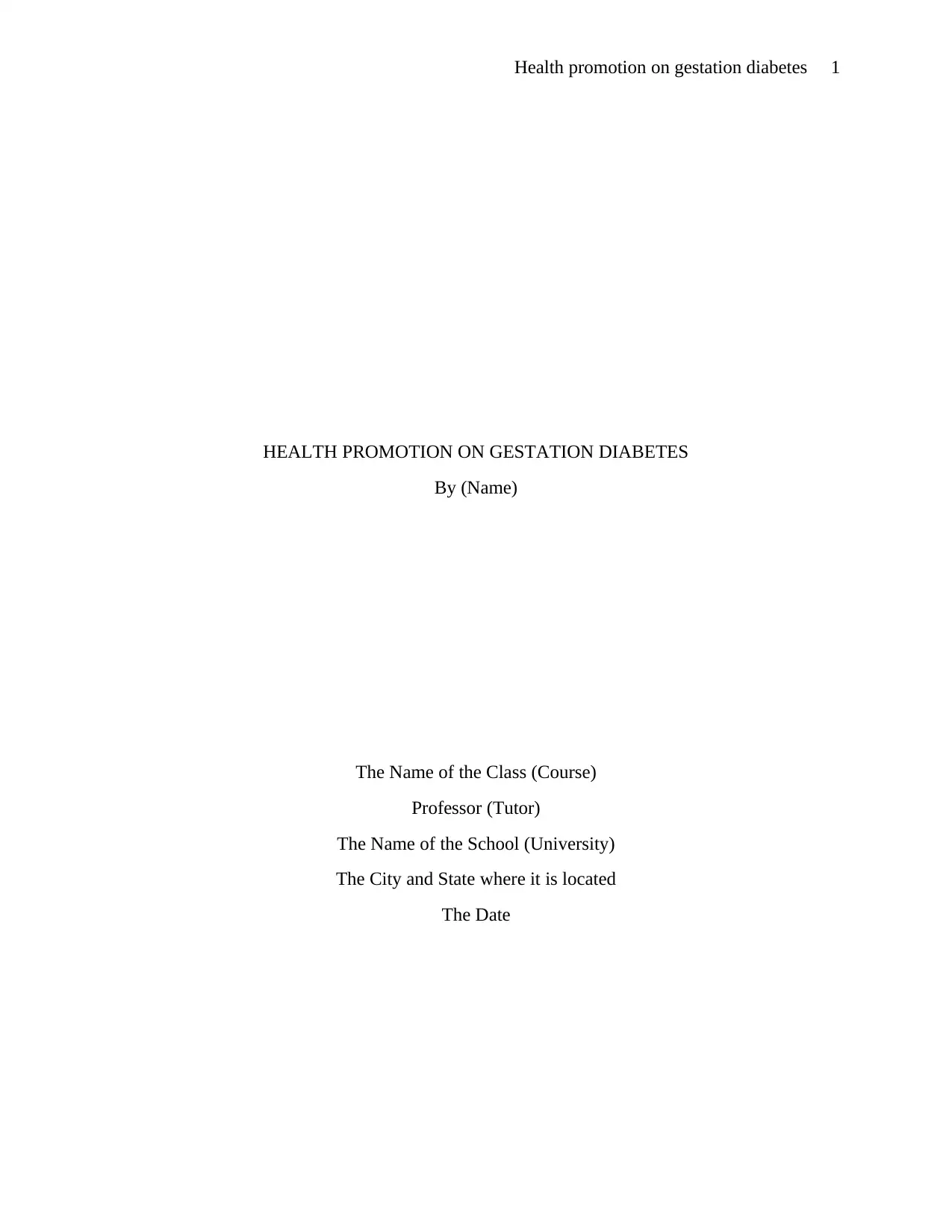
Health promotion on gestation diabetes 1
HEALTH PROMOTION ON GESTATION DIABETES
By (Name)
The Name of the Class (Course)
Professor (Tutor)
The Name of the School (University)
The City and State where it is located
The Date
HEALTH PROMOTION ON GESTATION DIABETES
By (Name)
The Name of the Class (Course)
Professor (Tutor)
The Name of the School (University)
The City and State where it is located
The Date
Paraphrase This Document
Need a fresh take? Get an instant paraphrase of this document with our AI Paraphraser
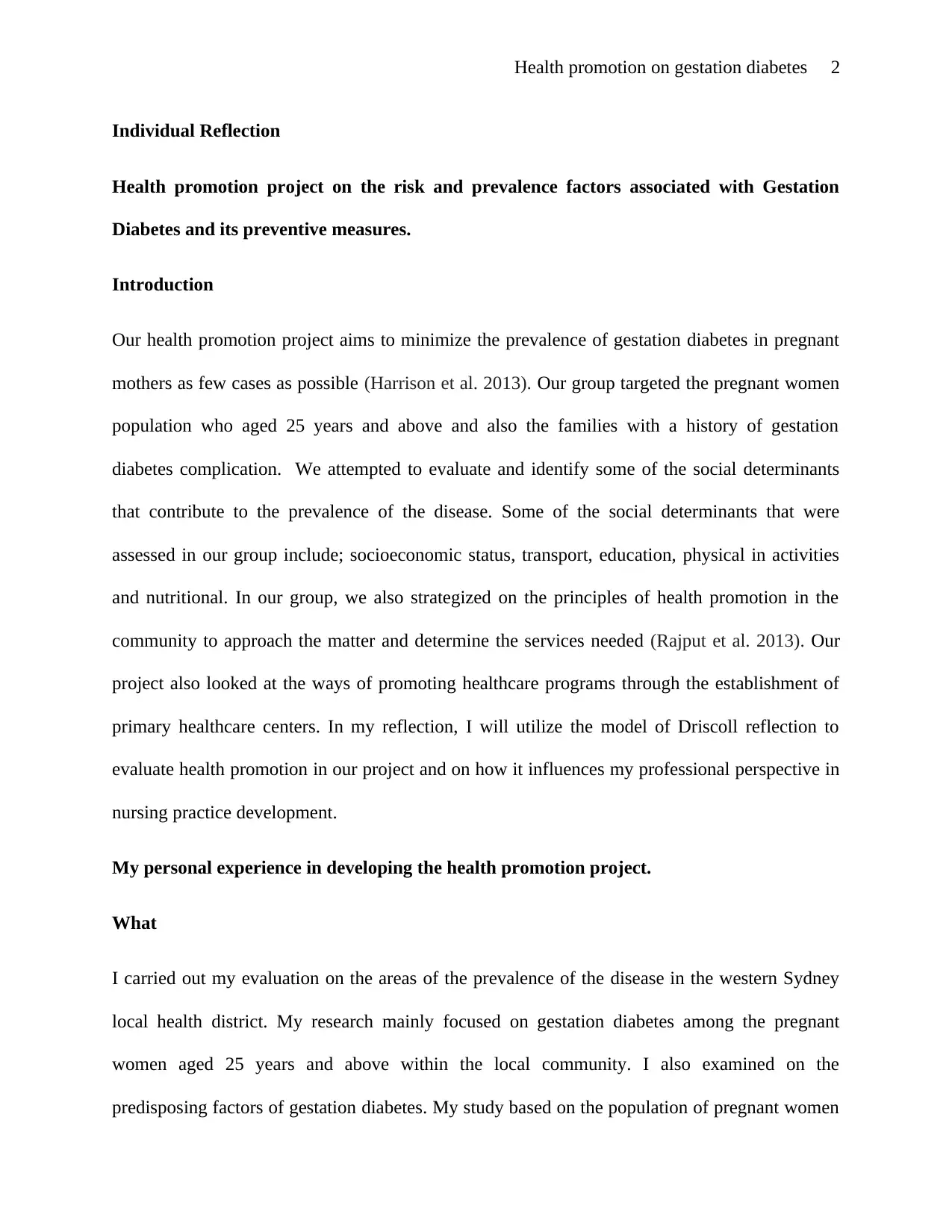
Health promotion on gestation diabetes 2
Individual Reflection
Health promotion project on the risk and prevalence factors associated with Gestation
Diabetes and its preventive measures.
Introduction
Our health promotion project aims to minimize the prevalence of gestation diabetes in pregnant
mothers as few cases as possible (Harrison et al. 2013). Our group targeted the pregnant women
population who aged 25 years and above and also the families with a history of gestation
diabetes complication. We attempted to evaluate and identify some of the social determinants
that contribute to the prevalence of the disease. Some of the social determinants that were
assessed in our group include; socioeconomic status, transport, education, physical in activities
and nutritional. In our group, we also strategized on the principles of health promotion in the
community to approach the matter and determine the services needed (Rajput et al. 2013). Our
project also looked at the ways of promoting healthcare programs through the establishment of
primary healthcare centers. In my reflection, I will utilize the model of Driscoll reflection to
evaluate health promotion in our project and on how it influences my professional perspective in
nursing practice development.
My personal experience in developing the health promotion project.
What
I carried out my evaluation on the areas of the prevalence of the disease in the western Sydney
local health district. My research mainly focused on gestation diabetes among the pregnant
women aged 25 years and above within the local community. I also examined on the
predisposing factors of gestation diabetes. My study based on the population of pregnant women
Individual Reflection
Health promotion project on the risk and prevalence factors associated with Gestation
Diabetes and its preventive measures.
Introduction
Our health promotion project aims to minimize the prevalence of gestation diabetes in pregnant
mothers as few cases as possible (Harrison et al. 2013). Our group targeted the pregnant women
population who aged 25 years and above and also the families with a history of gestation
diabetes complication. We attempted to evaluate and identify some of the social determinants
that contribute to the prevalence of the disease. Some of the social determinants that were
assessed in our group include; socioeconomic status, transport, education, physical in activities
and nutritional. In our group, we also strategized on the principles of health promotion in the
community to approach the matter and determine the services needed (Rajput et al. 2013). Our
project also looked at the ways of promoting healthcare programs through the establishment of
primary healthcare centers. In my reflection, I will utilize the model of Driscoll reflection to
evaluate health promotion in our project and on how it influences my professional perspective in
nursing practice development.
My personal experience in developing the health promotion project.
What
I carried out my evaluation on the areas of the prevalence of the disease in the western Sydney
local health district. My research mainly focused on gestation diabetes among the pregnant
women aged 25 years and above within the local community. I also examined on the
predisposing factors of gestation diabetes. My study based on the population of pregnant women
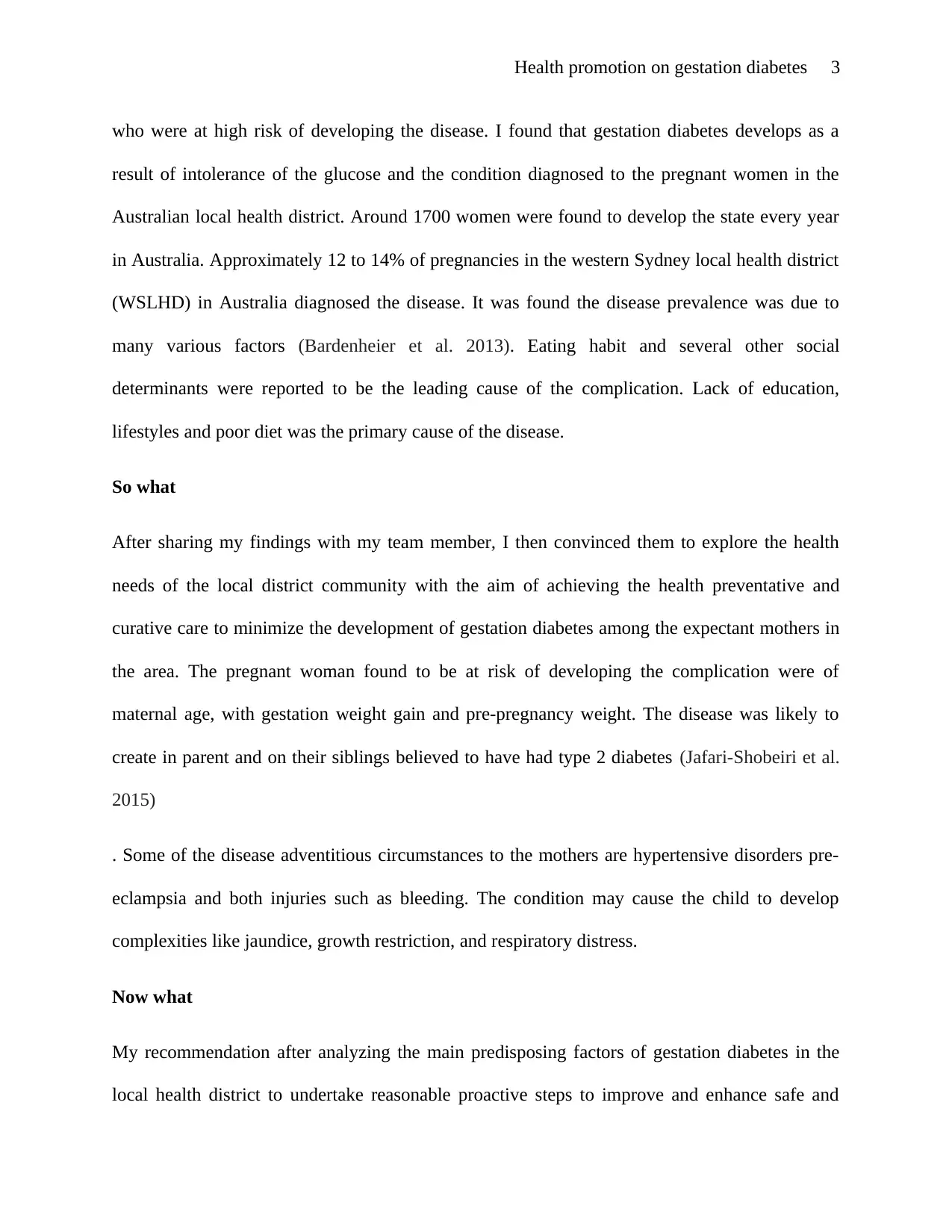
Health promotion on gestation diabetes 3
who were at high risk of developing the disease. I found that gestation diabetes develops as a
result of intolerance of the glucose and the condition diagnosed to the pregnant women in the
Australian local health district. Around 1700 women were found to develop the state every year
in Australia. Approximately 12 to 14% of pregnancies in the western Sydney local health district
(WSLHD) in Australia diagnosed the disease. It was found the disease prevalence was due to
many various factors (Bardenheier et al. 2013). Eating habit and several other social
determinants were reported to be the leading cause of the complication. Lack of education,
lifestyles and poor diet was the primary cause of the disease.
So what
After sharing my findings with my team member, I then convinced them to explore the health
needs of the local district community with the aim of achieving the health preventative and
curative care to minimize the development of gestation diabetes among the expectant mothers in
the area. The pregnant woman found to be at risk of developing the complication were of
maternal age, with gestation weight gain and pre-pregnancy weight. The disease was likely to
create in parent and on their siblings believed to have had type 2 diabetes (Jafari-Shobeiri et al.
2015)
. Some of the disease adventitious circumstances to the mothers are hypertensive disorders pre-
eclampsia and both injuries such as bleeding. The condition may cause the child to develop
complexities like jaundice, growth restriction, and respiratory distress.
Now what
My recommendation after analyzing the main predisposing factors of gestation diabetes in the
local health district to undertake reasonable proactive steps to improve and enhance safe and
who were at high risk of developing the disease. I found that gestation diabetes develops as a
result of intolerance of the glucose and the condition diagnosed to the pregnant women in the
Australian local health district. Around 1700 women were found to develop the state every year
in Australia. Approximately 12 to 14% of pregnancies in the western Sydney local health district
(WSLHD) in Australia diagnosed the disease. It was found the disease prevalence was due to
many various factors (Bardenheier et al. 2013). Eating habit and several other social
determinants were reported to be the leading cause of the complication. Lack of education,
lifestyles and poor diet was the primary cause of the disease.
So what
After sharing my findings with my team member, I then convinced them to explore the health
needs of the local district community with the aim of achieving the health preventative and
curative care to minimize the development of gestation diabetes among the expectant mothers in
the area. The pregnant woman found to be at risk of developing the complication were of
maternal age, with gestation weight gain and pre-pregnancy weight. The disease was likely to
create in parent and on their siblings believed to have had type 2 diabetes (Jafari-Shobeiri et al.
2015)
. Some of the disease adventitious circumstances to the mothers are hypertensive disorders pre-
eclampsia and both injuries such as bleeding. The condition may cause the child to develop
complexities like jaundice, growth restriction, and respiratory distress.
Now what
My recommendation after analyzing the main predisposing factors of gestation diabetes in the
local health district to undertake reasonable proactive steps to improve and enhance safe and
⊘ This is a preview!⊘
Do you want full access?
Subscribe today to unlock all pages.

Trusted by 1+ million students worldwide
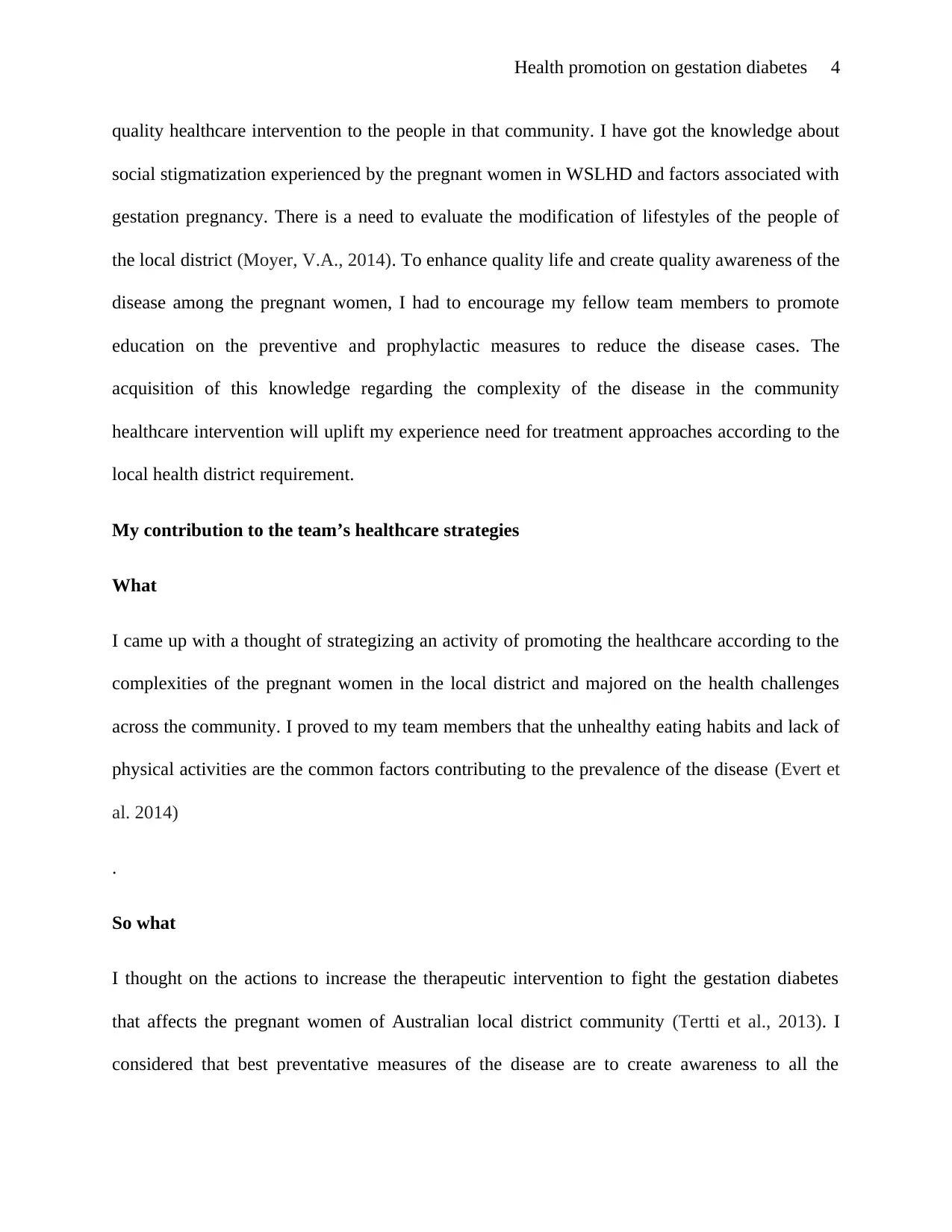
Health promotion on gestation diabetes 4
quality healthcare intervention to the people in that community. I have got the knowledge about
social stigmatization experienced by the pregnant women in WSLHD and factors associated with
gestation pregnancy. There is a need to evaluate the modification of lifestyles of the people of
the local district (Moyer, V.A., 2014). To enhance quality life and create quality awareness of the
disease among the pregnant women, I had to encourage my fellow team members to promote
education on the preventive and prophylactic measures to reduce the disease cases. The
acquisition of this knowledge regarding the complexity of the disease in the community
healthcare intervention will uplift my experience need for treatment approaches according to the
local health district requirement.
My contribution to the team’s healthcare strategies
What
I came up with a thought of strategizing an activity of promoting the healthcare according to the
complexities of the pregnant women in the local district and majored on the health challenges
across the community. I proved to my team members that the unhealthy eating habits and lack of
physical activities are the common factors contributing to the prevalence of the disease (Evert et
al. 2014)
.
So what
I thought on the actions to increase the therapeutic intervention to fight the gestation diabetes
that affects the pregnant women of Australian local district community (Tertti et al., 2013). I
considered that best preventative measures of the disease are to create awareness to all the
quality healthcare intervention to the people in that community. I have got the knowledge about
social stigmatization experienced by the pregnant women in WSLHD and factors associated with
gestation pregnancy. There is a need to evaluate the modification of lifestyles of the people of
the local district (Moyer, V.A., 2014). To enhance quality life and create quality awareness of the
disease among the pregnant women, I had to encourage my fellow team members to promote
education on the preventive and prophylactic measures to reduce the disease cases. The
acquisition of this knowledge regarding the complexity of the disease in the community
healthcare intervention will uplift my experience need for treatment approaches according to the
local health district requirement.
My contribution to the team’s healthcare strategies
What
I came up with a thought of strategizing an activity of promoting the healthcare according to the
complexities of the pregnant women in the local district and majored on the health challenges
across the community. I proved to my team members that the unhealthy eating habits and lack of
physical activities are the common factors contributing to the prevalence of the disease (Evert et
al. 2014)
.
So what
I thought on the actions to increase the therapeutic intervention to fight the gestation diabetes
that affects the pregnant women of Australian local district community (Tertti et al., 2013). I
considered that best preventative measures of the disease are to create awareness to all the
Paraphrase This Document
Need a fresh take? Get an instant paraphrase of this document with our AI Paraphraser

Health promotion on gestation diabetes 5
women of age between 17 to 35 years. I will organize with my team members on how to conduct
such education to the local district natives.
Now what
I will acquire the knowledge and experience from learning and evaluate the predisposing social
factors that result in the disease through education to the people. These social determinant
include; eating habits physical activities and psychosocial health. Social, economic status is
another factor that affects the people as those with low socioeconomic status suffered most from
these chronic diseases. I will try to organize with my multidisciplinary group with the aim of
improving the healthcare. I can utter that integration confidentially with community-based
intervention to provide healthcare with enhancing the people's health and reduce the risk of
developing chronic diseases.
The contribution of my teams approach in healthcare promotion principles and practices
What
The formation of therapeutic strategies and policy is crucial for understanding the needs of the
local health district. My team members got aware of the information features that dominate the
influence pattern of the treatment relationship between the community of the WSLHD and the
nurses. My healthcare team understands the need to educate the patient and their relatives on
where to get assistance and how to manage the disease in casein issue arises. Afterward, I gained
full insight involving the needs of understanding the cultural beliefs and convections towards the
treatment of the gestation diabetes.
So what
women of age between 17 to 35 years. I will organize with my team members on how to conduct
such education to the local district natives.
Now what
I will acquire the knowledge and experience from learning and evaluate the predisposing social
factors that result in the disease through education to the people. These social determinant
include; eating habits physical activities and psychosocial health. Social, economic status is
another factor that affects the people as those with low socioeconomic status suffered most from
these chronic diseases. I will try to organize with my multidisciplinary group with the aim of
improving the healthcare. I can utter that integration confidentially with community-based
intervention to provide healthcare with enhancing the people's health and reduce the risk of
developing chronic diseases.
The contribution of my teams approach in healthcare promotion principles and practices
What
The formation of therapeutic strategies and policy is crucial for understanding the needs of the
local health district. My team members got aware of the information features that dominate the
influence pattern of the treatment relationship between the community of the WSLHD and the
nurses. My healthcare team understands the need to educate the patient and their relatives on
where to get assistance and how to manage the disease in casein issue arises. Afterward, I gained
full insight involving the needs of understanding the cultural beliefs and convections towards the
treatment of the gestation diabetes.
So what
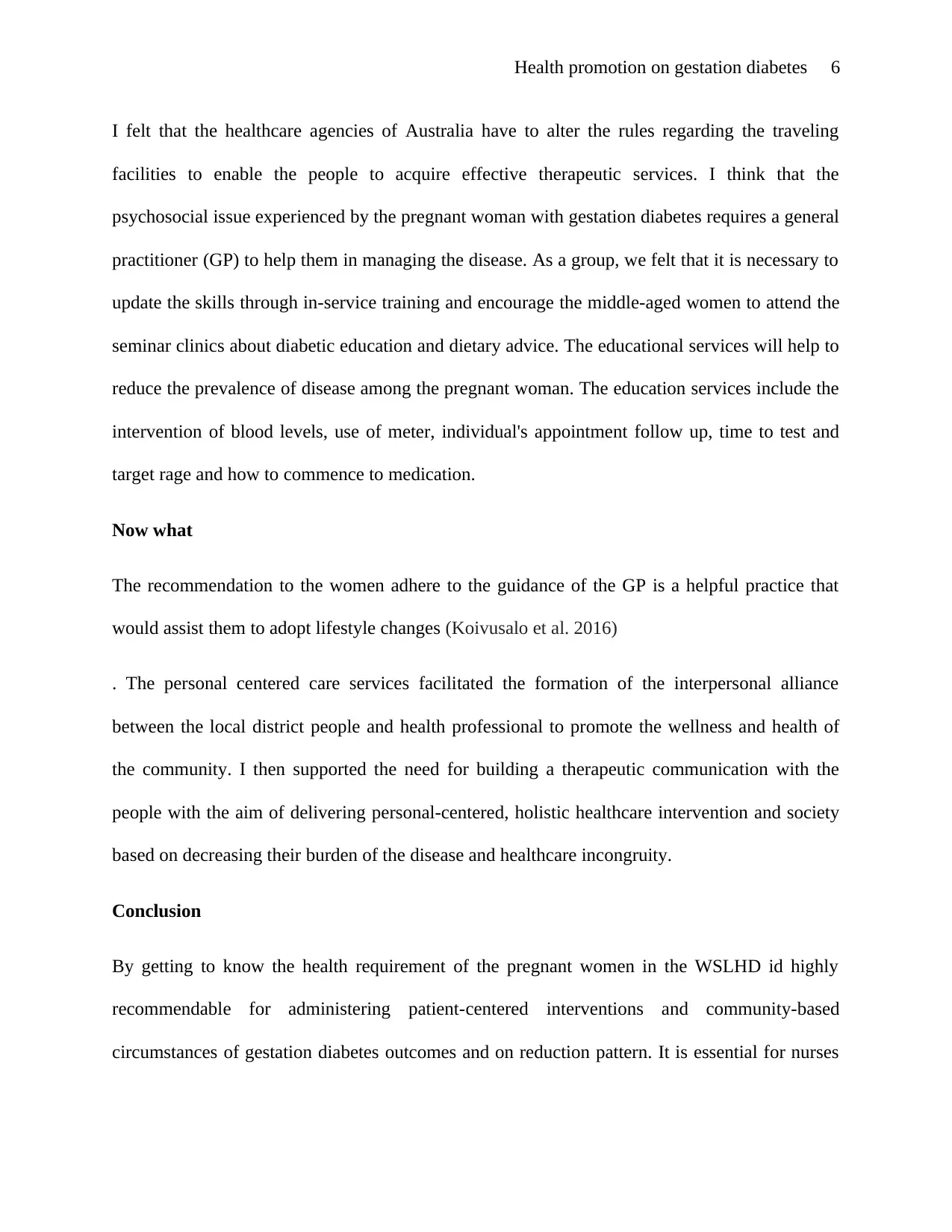
Health promotion on gestation diabetes 6
I felt that the healthcare agencies of Australia have to alter the rules regarding the traveling
facilities to enable the people to acquire effective therapeutic services. I think that the
psychosocial issue experienced by the pregnant woman with gestation diabetes requires a general
practitioner (GP) to help them in managing the disease. As a group, we felt that it is necessary to
update the skills through in-service training and encourage the middle-aged women to attend the
seminar clinics about diabetic education and dietary advice. The educational services will help to
reduce the prevalence of disease among the pregnant woman. The education services include the
intervention of blood levels, use of meter, individual's appointment follow up, time to test and
target rage and how to commence to medication.
Now what
The recommendation to the women adhere to the guidance of the GP is a helpful practice that
would assist them to adopt lifestyle changes (Koivusalo et al. 2016)
. The personal centered care services facilitated the formation of the interpersonal alliance
between the local district people and health professional to promote the wellness and health of
the community. I then supported the need for building a therapeutic communication with the
people with the aim of delivering personal-centered, holistic healthcare intervention and society
based on decreasing their burden of the disease and healthcare incongruity.
Conclusion
By getting to know the health requirement of the pregnant women in the WSLHD id highly
recommendable for administering patient-centered interventions and community-based
circumstances of gestation diabetes outcomes and on reduction pattern. It is essential for nurses
I felt that the healthcare agencies of Australia have to alter the rules regarding the traveling
facilities to enable the people to acquire effective therapeutic services. I think that the
psychosocial issue experienced by the pregnant woman with gestation diabetes requires a general
practitioner (GP) to help them in managing the disease. As a group, we felt that it is necessary to
update the skills through in-service training and encourage the middle-aged women to attend the
seminar clinics about diabetic education and dietary advice. The educational services will help to
reduce the prevalence of disease among the pregnant woman. The education services include the
intervention of blood levels, use of meter, individual's appointment follow up, time to test and
target rage and how to commence to medication.
Now what
The recommendation to the women adhere to the guidance of the GP is a helpful practice that
would assist them to adopt lifestyle changes (Koivusalo et al. 2016)
. The personal centered care services facilitated the formation of the interpersonal alliance
between the local district people and health professional to promote the wellness and health of
the community. I then supported the need for building a therapeutic communication with the
people with the aim of delivering personal-centered, holistic healthcare intervention and society
based on decreasing their burden of the disease and healthcare incongruity.
Conclusion
By getting to know the health requirement of the pregnant women in the WSLHD id highly
recommendable for administering patient-centered interventions and community-based
circumstances of gestation diabetes outcomes and on reduction pattern. It is essential for nurses
⊘ This is a preview!⊘
Do you want full access?
Subscribe today to unlock all pages.

Trusted by 1+ million students worldwide
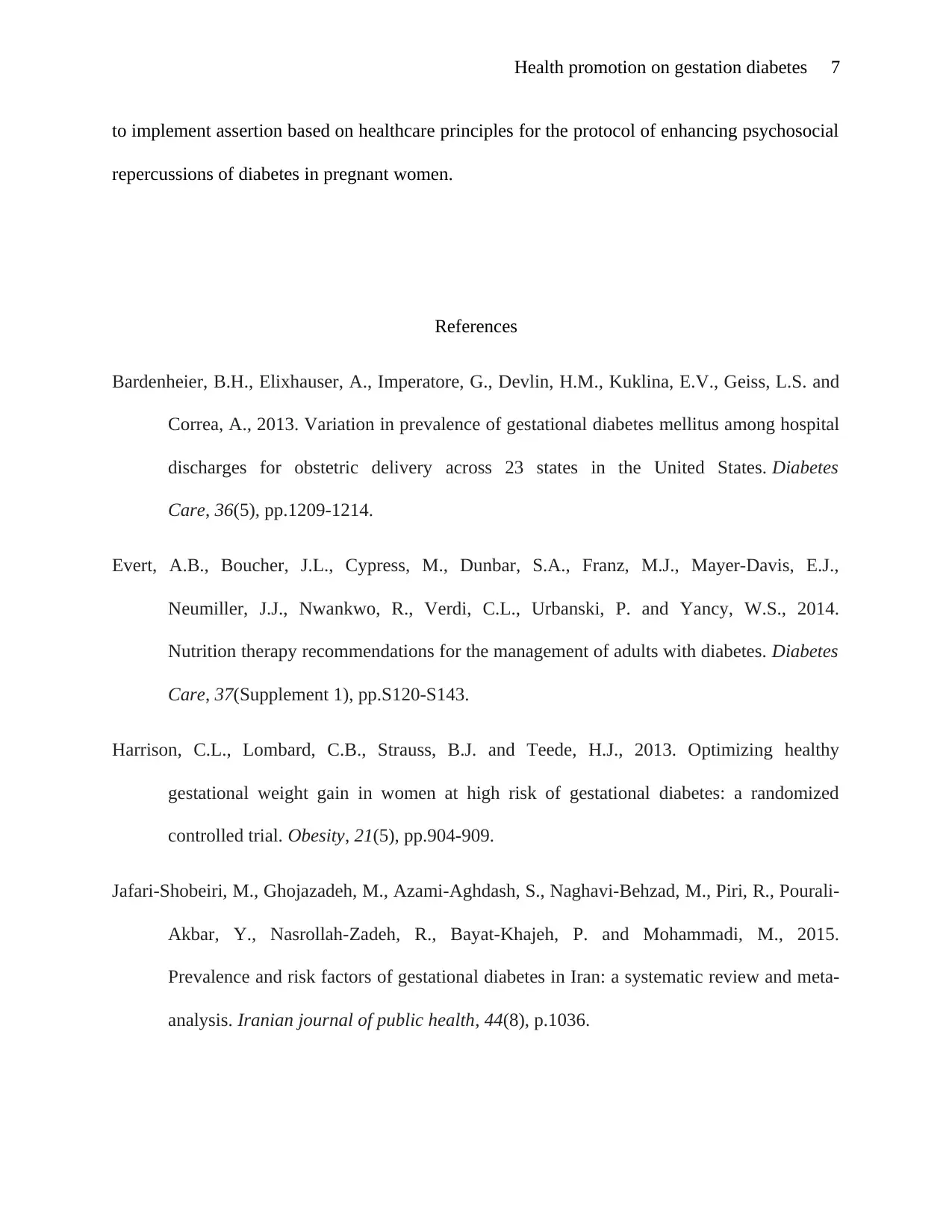
Health promotion on gestation diabetes 7
to implement assertion based on healthcare principles for the protocol of enhancing psychosocial
repercussions of diabetes in pregnant women.
References
Bardenheier, B.H., Elixhauser, A., Imperatore, G., Devlin, H.M., Kuklina, E.V., Geiss, L.S. and
Correa, A., 2013. Variation in prevalence of gestational diabetes mellitus among hospital
discharges for obstetric delivery across 23 states in the United States. Diabetes
Care, 36(5), pp.1209-1214.
Evert, A.B., Boucher, J.L., Cypress, M., Dunbar, S.A., Franz, M.J., Mayer-Davis, E.J.,
Neumiller, J.J., Nwankwo, R., Verdi, C.L., Urbanski, P. and Yancy, W.S., 2014.
Nutrition therapy recommendations for the management of adults with diabetes. Diabetes
Care, 37(Supplement 1), pp.S120-S143.
Harrison, C.L., Lombard, C.B., Strauss, B.J. and Teede, H.J., 2013. Optimizing healthy
gestational weight gain in women at high risk of gestational diabetes: a randomized
controlled trial. Obesity, 21(5), pp.904-909.
Jafari-Shobeiri, M., Ghojazadeh, M., Azami-Aghdash, S., Naghavi-Behzad, M., Piri, R., Pourali-
Akbar, Y., Nasrollah-Zadeh, R., Bayat-Khajeh, P. and Mohammadi, M., 2015.
Prevalence and risk factors of gestational diabetes in Iran: a systematic review and meta-
analysis. Iranian journal of public health, 44(8), p.1036.
to implement assertion based on healthcare principles for the protocol of enhancing psychosocial
repercussions of diabetes in pregnant women.
References
Bardenheier, B.H., Elixhauser, A., Imperatore, G., Devlin, H.M., Kuklina, E.V., Geiss, L.S. and
Correa, A., 2013. Variation in prevalence of gestational diabetes mellitus among hospital
discharges for obstetric delivery across 23 states in the United States. Diabetes
Care, 36(5), pp.1209-1214.
Evert, A.B., Boucher, J.L., Cypress, M., Dunbar, S.A., Franz, M.J., Mayer-Davis, E.J.,
Neumiller, J.J., Nwankwo, R., Verdi, C.L., Urbanski, P. and Yancy, W.S., 2014.
Nutrition therapy recommendations for the management of adults with diabetes. Diabetes
Care, 37(Supplement 1), pp.S120-S143.
Harrison, C.L., Lombard, C.B., Strauss, B.J. and Teede, H.J., 2013. Optimizing healthy
gestational weight gain in women at high risk of gestational diabetes: a randomized
controlled trial. Obesity, 21(5), pp.904-909.
Jafari-Shobeiri, M., Ghojazadeh, M., Azami-Aghdash, S., Naghavi-Behzad, M., Piri, R., Pourali-
Akbar, Y., Nasrollah-Zadeh, R., Bayat-Khajeh, P. and Mohammadi, M., 2015.
Prevalence and risk factors of gestational diabetes in Iran: a systematic review and meta-
analysis. Iranian journal of public health, 44(8), p.1036.
Paraphrase This Document
Need a fresh take? Get an instant paraphrase of this document with our AI Paraphraser

Health promotion on gestation diabetes 8
Koivusalo, S.B., Rönö, K., Klemetti, M.M., Roine, R.P., Lindström, J., Erkkola, M., Kaaja, R.J.,
Pöyhönen-Alho, M., Tiitinen, A., Huvinen, E. and Andersson, S., 2016. Gestational
diabetes mellitus can be prevented by lifestyle intervention: the Finnish Gestational
Diabetes Prevention Study (RADIAL): a randomized controlled trial. Diabetes
Care, 39(1), pp.24-30.
Moyer, V.A., 2014. Screening for gestational diabetes mellitus: US Preventive Services Task
Force recommendation statement. Annals of internal medicine, 160(6), pp.414-420.
Rajput, R., Yadav, Y., Nanda, S. and Rajput, M., 2013. Prevalence of gestational diabetes
mellitus & associated risk factors at a tertiary care hospital in Haryana. The Indian
journal of medical research, 137(4), p.728.
Tertti, K., Ekblad, U., Koskinen, P., Vahlberg, T., and Rönnemaa, T., 2013. Metformin vs.
insulin in gestational diabetes. A randomized study is characterizing metformin patients
needing additional insulin. Diabetes, Obesity and Metabolism, 15(3), pp.246-251.
Koivusalo, S.B., Rönö, K., Klemetti, M.M., Roine, R.P., Lindström, J., Erkkola, M., Kaaja, R.J.,
Pöyhönen-Alho, M., Tiitinen, A., Huvinen, E. and Andersson, S., 2016. Gestational
diabetes mellitus can be prevented by lifestyle intervention: the Finnish Gestational
Diabetes Prevention Study (RADIAL): a randomized controlled trial. Diabetes
Care, 39(1), pp.24-30.
Moyer, V.A., 2014. Screening for gestational diabetes mellitus: US Preventive Services Task
Force recommendation statement. Annals of internal medicine, 160(6), pp.414-420.
Rajput, R., Yadav, Y., Nanda, S. and Rajput, M., 2013. Prevalence of gestational diabetes
mellitus & associated risk factors at a tertiary care hospital in Haryana. The Indian
journal of medical research, 137(4), p.728.
Tertti, K., Ekblad, U., Koskinen, P., Vahlberg, T., and Rönnemaa, T., 2013. Metformin vs.
insulin in gestational diabetes. A randomized study is characterizing metformin patients
needing additional insulin. Diabetes, Obesity and Metabolism, 15(3), pp.246-251.

Health promotion on gestation diabetes 9
⊘ This is a preview!⊘
Do you want full access?
Subscribe today to unlock all pages.

Trusted by 1+ million students worldwide
1 out of 9
Related Documents
Your All-in-One AI-Powered Toolkit for Academic Success.
+13062052269
info@desklib.com
Available 24*7 on WhatsApp / Email
![[object Object]](/_next/static/media/star-bottom.7253800d.svg)
Unlock your academic potential
Copyright © 2020–2025 A2Z Services. All Rights Reserved. Developed and managed by ZUCOL.





